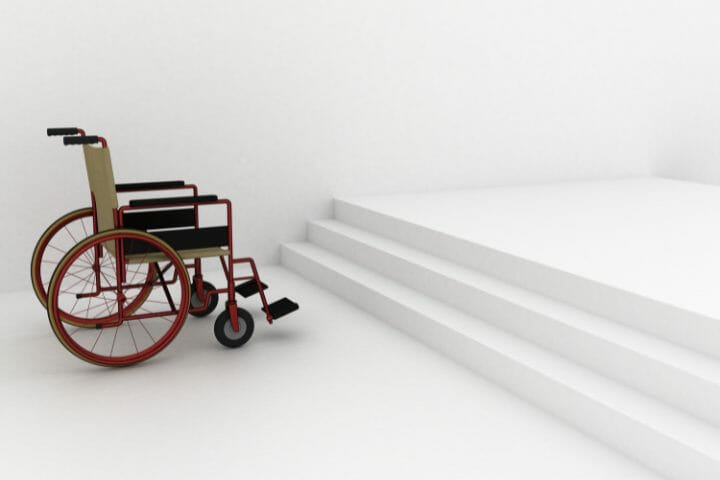Has your wheelchair been giving you some trouble lately? Wheels not working smoothly as they used to? Wondering how to fix a wheelchair wheel? We have got all the answers for you right this in this in-depth guide on fixing wheelchair wheels.
Contents
A temporary illness or a lifelong disability can push you to use a wheelchair. It can be disheartening to use a wheelchair for some time, but you are not alone in dealing with this pain. In the US, almost 2.7 million people use wheelchairs.

A wheelchair, like any other device, needs maintenance from time to time. And since the wheels bear the entire weight of the patient, it often needs replacements and fixing.
It’s crucial to know that wheelchairs, manual or electric, come in various designs, sizes, and materials in accordance with the user’s condition and lifestyle. So, in some cases, the wheel’s layout can be different and include two sets of wheels or perhaps one caster.
If you are a caregiver, you need to learn how to fix a wheelchair wheel. Whether it is electric or manual, we have got you covered. Take a look!
You might also like to read: How To Make Your Car Wheelchair Accessible?
Electric Wheelchairs
Electric wheelchair wheels may not be the real problem, even though you might think the damage is with the wheel. The real reason why your power wheelchair wheels are non functional are two fold:
Battery issues
Batteries power powered wheelchairs to power them to function. While it is generally reliable, batteries can fail. They aren’t common.
It could be as simple as requiring a battery charge, or the battery might not have a charge and may need to be replaced. Batteries typically become less efficient over time. Then the performance will be less than optimal for at least one year or more, depending on your usage patterns.
If poor battery performance is beginning to interfere with the way you utilize your chair daily and you’re thinking of replacing the battery.

Electrical faults
The majority of powered wheelchairs are troubled with electrical issues. Connectors may break, the responsiveness of your wheelchair can fluctuate, and your chair cannot even function.
If your battery has been fully charged and your levers for your freewheel are locked, however, if you’re experiencing difficulty getting your wheelchair in motion, it may be an electrical issue within the unit.
You might also like to read: How to Choose a Wheelchair for the Elderly
Manual Wheelchairs
If a pneumatic tire is flat, your caster seems unsteady, or a creaking sound emanating from your rear wheel sends your hair to the floor, it may be time to replace it.
Although it might seem like a difficult task, it’s easy for most people and essential to keep your wheelchair operating in prime condition.
Before you open the toolbox and begin throwing bolts, let’s review the basic wheelbase configuration for a manual chair because it has two distinct kinds of wheels.
- The wheels on the front, also known as “casters,” are smaller in size, and they swivel in all directions, assisting in mobility.
- “Rear wheels” (also known as “drive wheels” are the larger set located in the rear of the chair. They are the ones that the user can propel in either direction, forward or backward, using the push rims.
Let’s see how we can replace the various parts of the wheels:

Replacing Wheelchair Wheel Assemblies
Just like cars are equipped with tires that must be replaced, similarly, wheelchairs’ wheel must also be replaced to ensure the maximum effectiveness of your wheelchair’s performance. If a pneumatic tire becomes flat, your caster seems unstable, or a squeaking sound from the rear wheel is driving you mad, it could be time to replace it.
You might be wondering how to change wheelchair tires on your wheelchair, and it may seem like a daunting job for someone who is immobile. However, replacing wheels on wheelchairs is quite simple.
Replacing the caster:
Step 1: Use a socket and a wrench to loosen the caster’s bolt. Now take off the caster, washer and bolt.
Step 2: Now, fit the bolt through the fork, and then the washer. Align the new caster wheel in between the forks, then insert another washer, and the last bolt.
Step 3: Place the nut and with a wrench and socket, tighten the configuration in place.

Replacing Rear Wheel:
Step 1: First, remove the rear wheel using a wrench, socket and screwdriver. Use a flathead screwdriver under the center hub to remove it.
Step 2: Now install the new wheel. Insert bolt through the fork, and the washer. Align the wheel between the forks and insert the bolt through the wheel. Place the washer, and slide the bolt through the other fork. Tighten the nut and place the center hub back in position. Gently tap it into place using the screwdriver.
You might also like to read: A Guide on How to Get a Wheelchair for Free
How to Tighten Wheelchair Wheels?
The rear wheels on the chair are utilized to propel. If the wheel becomes loose, you can suffer from a fall or damage the wheelchair. Here’s how you can tighten the wheels:
Step 1: Check the chair to determine which wheel is loose. The bolt’s outer end should be tightened using the socket wrench.
Step 2: Close the nut on the back of the chair using a 19mm wrench

How Do You Fill A Wheelchair Tires?
Have you ever filled air in your bike tires? If yes, then you can easily fill a wheelchair tire because both the vehicle uses same tools and techniques to fill air.
To fill a wheelchair tire all you need is a pressure gauge, valve and hand or foot air pump. Attach the valve to the inner tire valve and connect it to the air pump. Now fill the tire with air. Ensure you have a pressure gauge on the pump else you may fill excess air and this may ruin your wheelchair tire.
Fill only what is prescribed by the manufacturer or it may damage the tire and cost you a big time. After filling the air put the inner tire valve cap back and your task is done!
You might also like to read: Best Accessible Airlines for Disabled Passengers and Wheelchair Users
Common Tools Used For Wheelchair Tire Maintenance
Air Pump
The air pump is required to refill pneumatic wheelchair tires after being installed. It is also beneficial to have an air pump to keep the air pressure up because wheelchair tires have to be inflated at least every time.
If you’re using the electric or compressor, you must be careful as the tubes smaller than those used in wheelchairs may quickly fill up and explode easily.
Air Pressure Gauge
This instrument is used to measure the pressure of air during the installation of the tires and at regular intervals to examine the tire pressure. Certain cycle pumps have the pressure gauge built-in as an integral part of the pump.

Tire Levers
You can utilize the levers on the tire to push the tire’s bead upwards and over the rim. They are generally available in lever handles made of plastic or heavy-duty lever handles in metal. They make fitting wheelchair tires much simpler.
Foam Tires Installation Tool
Foam-filled tires comprise a bead’s width slightly wider than the rim’s bead. The tool works by compressing both rim halves while keeping that tire at the center, which allows the bolts and screws (meant to join them) to pass through to the opposite side.
You might also like to read: A Complete Guide to Make a Wheelchair Accessible Home and Business
Common Wheelchair Faults and How to Fix Them
Worn out, damaged or ill-fitting upholstery
Certain wheelchair users require additional padding or cushioning to provide increased support and comfort to meet their requirements.
If the upholstery of your wheelchair has been damaged or has deteriorated to the point of extreme wear, it will ned to be fixed .
Depending on whether it is only the upholstery or whether the padding has become thinner, you might have to remove your wheelchair seat from the assembly.
Talk to a technical expert, who can patch up damaged upholstery or replace existing upholstery. In some cases, they can add extra padding as well to the seat, to get you back on a comfortable ride.
In this case, you will need to remove the chair and get the padding replaced . The issue should be addressed quickly.

Unlocked/locked freewheel lever
The freewheel levers located on the back of your wheelchair can be a valuable device. However, many wheelchair users might not be aware of how they work.
The levers on the freewheel allow you to switch your wheelchair’s operation from manual to motorized or vice versa. It can be helpful when the battery is drained or you prefer to use your wheelchair by hand.
This problem you cannot fix on your own. Hence, contact your wheelchair’s manufacturer.
You might also like to read: Buying a Used Wheelchair? 6 Things You Must Know Before Buying One
A Few Final Words
A wheelchair becomes an inseparable part of your life if you have severe disability hence keeping it in a good shape becomes imperative. There are a few fixes which you can do on your own by going through some videos but for some you will need expert help. However, you can easily replace the wheels of your wheelchair on your own. So replace it today!
